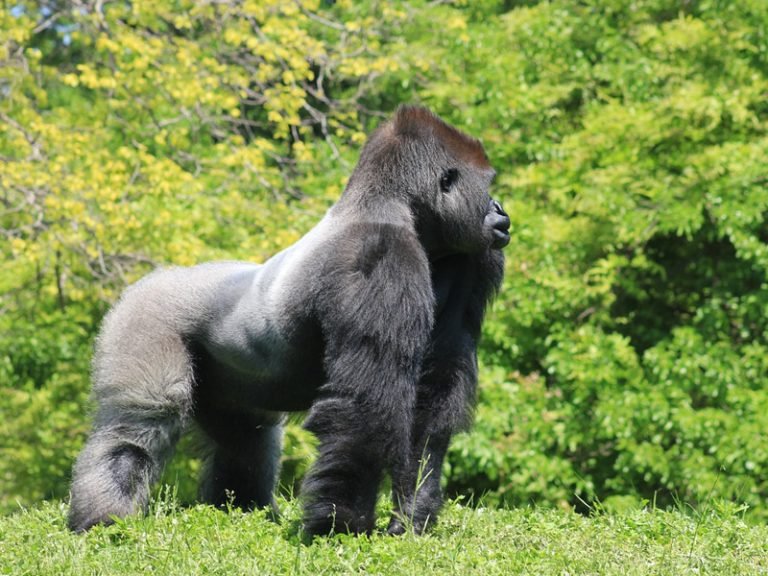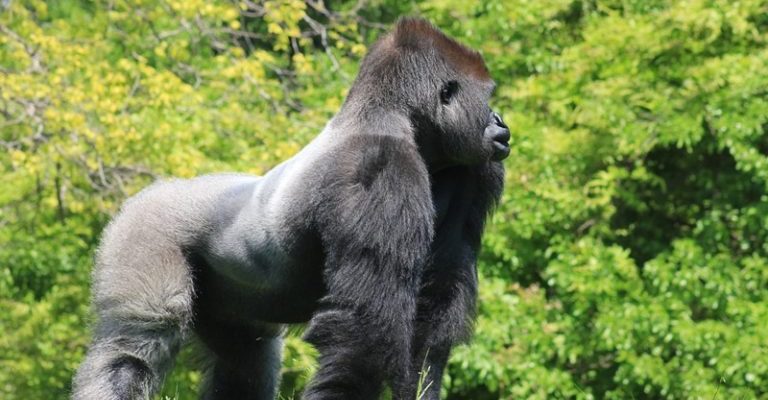
These incredible animals are split into two subspecies: the Mountain Gorilla and the Eastern Lowland Gorilla. Both types live in specific habitats that shape their lives, behaviors, and interactions with their environment. As we dive into the top ten facts about the Eastern Gorilla, you’ll discover not just their unique features, but also why they deserve our attention and protection. So, grab your coffee, and let’s explore the world of the Eastern Gorilla together!
1. Their Size is Impressive!
Eastern Gorillas are among the largest primates in the world. Adult males can weigh between 300 to 485 pounds! That’s about the weight of a small car—imagine that bulk moving gracefully through the trees. While females are smaller, they still weigh between 150 to 250 pounds, showcasing a striking difference in size.
These gorillas have strong muscles and a robust build, ideal for climbing trees and navigating through their forest homes. But here’s the thing: despite their bulk, Eastern Gorillas are primarily gentle giants. They spend most of their time foraging for food, hanging out with family, and nurturing their young. Their size is an impressive trait, but it serves a purpose, allowing them to thrive in their natural habitat.
2. They’re Social Creatures
You might be wondering how these colossal animals interact with each other. Eastern Gorillas are incredibly social beings. They live in family groups called troops, typically led by a dominant male known as a silverback. This silverback is responsible for the group’s safety and well-being, acting as a protector and leader.
Troops usually consist of several females and their offspring, but they can range from just a few individuals to over twenty. Within these groups, gorillas communicate through a variety of vocalizations, body language, and facial expressions. They groom each other, which helps strengthen social bonds—think of it as their way of hanging out and catching up. Honestly, it’s heartwarming to realize how closely they bond with one another.
3. They Have Unique Diets
Let’s talk about what these big guys eat! Eastern Gorillas are herbivores, mainly munching on leaves, stems, flowers, and fruit. You might think that’s not much of a diet, but here’s the thing: they consume an astonishing variety of over 100 different plant species! They really know how to keep their meals interesting.
Their favorite snack? The young leaves from trees; they’re packed with nutrients. Gorillas spend up to 10 hours a day looking for food! This constant foraging helps keep the ecosystem in balance, as they spread seeds through their droppings, promoting plant growth. Plus, with their massive size, they need plenty of fuel to keep their energy up for those long days in the wild.
4. Mountain vs. Eastern Lowland Gorillas
In the realm of Eastern Gorillas, you’ll find two distinct subspecies: the Mountain Gorilla and the Eastern Lowland Gorilla. What’s the difference? Mountain Gorillas thrive in high-altitude forests, where temperatures can drop significantly. They have thicker fur, which helps them stay warm in their chilly climate.
On the other hand, the Eastern Lowland Gorillas are found in the lush lowland forests. They tend to be larger than their mountain cousins, with broader bodies and heavier frames. While they share many similarities, their habitats and adaptations to those environments create unique challenges and behaviors. Understanding these differences is crucial for conservation efforts as each subspecies faces its own set of threats due to habitat loss and poaching.
5. Communication Skills are Key
Eastern Gorillas have quite the social life, and communication is central to it. They use a mix of vocalizations like barks, grunts, and hoots, along with body language, to express their feelings and intentions. Imagine the variety of sounds they can produce—some are clear calls to alert the troop, while others can express excitement or distress.
Here’s a fun fact: gorillas can even convey emotions such as happiness or frustration through their faces. A relaxed gorilla might appear with a gentle expression, while a stressed one might show tension in its face. These skills not only help maintain harmony within the troop but also enable them to express their individual personalities. You might see two gorillas playing and communicating, and you’ll realize there’s a lot of depth to their interactions.
6. They’re at Risk of Extinction
Sadly, the Eastern Gorilla faces significant threats that have pushed them toward the edge of extinction. Habitat loss from logging and agricultural expansion, along with poaching and disease, have devastated their populations. The IUCN Red List classifies both subspecies as critically endangered, which means immediate action is needed to preserve their existence.
Conservation efforts are underway, with various organizations working to protect their habitats and educate local communities about the importance of gorillas. Efforts like ecotourism not only raise awareness but can also provide economic benefits to those living near gorilla habitats. By promoting the idea that healthy gorilla populations can bring jobs and income through tourism, we can foster a more supportive environment for their survival.
7. Incredible Parenting Skills
Eastern Gorilla mothers are known for their nurturing nature. A female typically gives birth to one baby after a gestation period of about 8.5 months. Just like humans, they bond closely with their little ones. Mothers will carry their infants on their backs, often for several years as they navigate the world together.
This maternal care is crucial for the development of baby gorillas. Mothers teach their young various survival skills, such as foraging for food and recognizing threats. Watching a mother gorilla tenderly care for her baby is a touching reminder of the strong family ties that exist in the animal kingdom. You might find yourself smiling as you observe these gentle giants interact and care for their young—it’s a sight to behold!
8. Super Strong, But Gentle
When it comes to strength, Eastern Gorillas are at the top of the list. They possess about six times the strength of an average human! That’s like having the muscle power of six people packed into one magnificent creature. Despite their immense strength, these gorillas are surprisingly gentle.
They rarely engage in conflict unless provoked, typically opting for displays of dominance rather than physical altercations. This duality—being both powerful and gentle—is a fascinating aspect of their character. It’s a reminder that strength doesn’t always have to be about aggression. They often prefer to avoid confrontations, focusing instead on maintaining peace within their troop.
9. Cultural Significance
In many cultures, Eastern Gorillas are seen as vital symbols of strength and family. Despite being endangered, they remain an important part of the folklore and traditions of the communities living near their habitats. Gorillas are often featured in stories and art, representing resilience and the connection between humans and nature.
Conservation efforts often use these cultural ties to promote awareness and protect gorillas. By highlighting their significance, communities can rally together to support initiatives aimed at preserving these incredible creatures. It’s a beautiful example of how culture can play a role in conservation and advocacy.
10. Inspiring Conservation Efforts
Lastly, the plight of the Eastern Gorilla has sparked incredible conservation initiatives worldwide. From protected habitats to anti-poaching patrols, organizations are working tirelessly to ensure the survival of these majestic beings. Ecotourism is also on the rise, allowing people to observe gorillas in their natural environment while contributing to conservation efforts.
Participating in these experiences can truly change perspectives, helping people understand the importance of protecting not just gorillas, but the entire ecosystem they inhabit. By sharing their stories and raising awareness about the Eastern Gorilla’s challenges, we can all play a part in ensuring their future survival.
As we wrap up our exploration of the Eastern Gorilla, it’s clear that these magnificent animals are both fascinating and vital to our world. Their strength, social nature, and the care they show for their young remind us of the beauty of wildlife. By understanding and supporting their conservation, we can help protect these gentle giants for generations to come.

